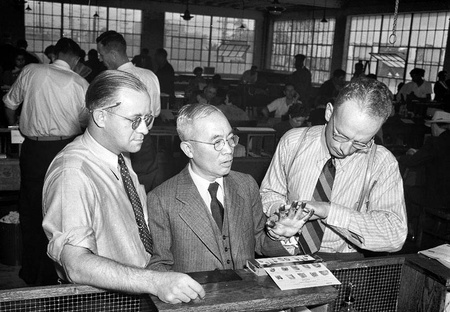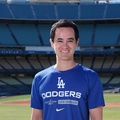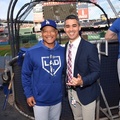
All of my grandparents passed away before I was born. My mother Kay lost her parents to tuberculosis just as World War II began and my father Khan’s mother died in the 1930s. His father Toyosaku Komai is the only one to live into the post-war era and he died in 1950. Because of that, I never had a sense of who my grandparents were when I was growing up. However, through connections of the family business and other circumstances, I have been the recipient of information about Toyosaku from any number of resources over the years. Trying to form a picture of my grandfather’s personality has been more like trying to solve a cold case mystery in that almost all of the witnesses have died and there is a limited written record. Yet precious bits of information continue to emerge from unexpected sources like a book on Issei baseball.
Perhaps because my siblings and I were fortunate that my mother was adopted by her uncle and aunt, who became our surrogate grandparents (a situation that confused me since no one has three sets of grandparents), I don’t recall much discussion of our parents’ parents. But some of my most distinct impressions of my grandfather came from my mother, who expressed sympathy for her father-in-law’s ultimate fate.
My mother believed Toyosaku’s life really ended on December 7, 1941, when the FBI came to his house and took him to jail. The pre-war publisher of the Rafu Shimpo newspaper, he was held without charge and without trial by the U.S. government in places like Missoula, Montana; Fort Sill, Oklahoma; Fort Livingston, Louisiana; and, finally, Santa Fe, New Mexico. Released in 1946 after the war ended, he was drastically changed by his isolation from his family and community.
When I began working for the Rafu Shimpo in the 1970s, there were a number of workers who had been with the newspaper before the war. Joe Yamada, a Lino typist, always referred to my grandfather as “H.T.” A 19-year-old immigrant from Yamanashi-ken, Japan, Toyosaku had taken the American name of Henry at some point and eventually was known by his initials. I have a vague memory of Japanese Editor Kiyoshi Yano mentioning my grandfather in some context, but nothing stuck in my head. Otherwise, very little about my grandfather was offered up by staff and I was not knowledgeable enough to even ask questions.
It was only when I began working at the Japanese American National Museum (JANM) that I learned from individual volunteers about my grandfather’s greatest failing: his drinking. Yoshiko Sakurai, whose father ran a restaurant in Little Tokyo, recalled seeing Toyosaku passed out on the couch in her father’s office several times. Archie Miyatake, Toyo’s son, once confided that his father had him drive Mr. Komai home on more than one occasion after imbibing.
Another JANM volunteer remembered coming into her living room as a little girl to see my grandfather asleep on their couch. They lived on the same block as my father’s family. The implication was that my grandmother locked her husband out of their husband because he was drunk. Again.
There’s a part of me that finds my grandfather interesting and colorful. But it also explains why my father and his siblings were not forthcoming on stories about their father. As a grandchild of a man who died before I was born, I have the distance to accept his character flaws as part of who he was. But for his own children, it must have been much more difficult, knowing the community was very aware that their father was a drunk.
I once asked my Aunt Haruyo (everyone called her “Happy”), my father’s only sister, why she continued to live at the family house after she got married. She confessed that her father had told her that if she moved out, he wanted to live with her and she did not want that responsibility for herself. Since her brothers, Akira (the oldest son) and Khan were also married, she could count on my mother and aunt to help with her father. So, he was clearly a handful.
To be fair, the other characteristic that so many people have passed on to me is that my grandfather was a community leader and very popular with everyone, including the police. Someone told me that the police would occasionally drive him home rather than arrest him for being intoxicated. He was also generous to other people in the community to the point where my mother told me that the family found money hidden away in books after my grandmother died.

But for all that, Toyosaku was a successful businessman. In 2003, the Rafu Shimpo marked its 100th anniversary by publishing a booklet about its history based on the research done by Katie Kaori Hayashi. From that, I learned that Toyosaku came to America and worked as a farm hand. He had ambition and became a labor contractor and managed a boarding house. Saving his money, he bought land in the Imperial Valley and then yobiyose (literally, “to call over,” a term I recently learned from scholar Charles Igawa) to his younger brother, Hisaji, who immigrated to America followed by two of their sisters.
My cousin Phillip, Hisaji’s grandson, noted that his father was born in the Imperial Valley. Phillip and I extrapolated that Toyosaku could have bought the land and then sent for Hisaji, or Hisaji arrived and Toyosaku purchased the property which his brother had some responsibility for farming. Without more information like dates, we’ll never know for sure, but I am confident that some version of our narrative is correct.
For me, getting these bits of information are like finding clues that help me to understand my family’s story and the context in which my grandparents and parents lived. That is why I was surprised and delighted to get an unexpected gift of history from the book, Issei Baseball: The Story of the First Japanese American Ballplayers by Robert Fitts.
Fitts has written several wonderful books about the connection to Japanese baseball and America. His work, Mashi: The Unfulfilled Baseball Dreams of Masanori Murakami, the First Japanese Major Leaguer (Nebraska, 2015) is fantastic for someone my age who remembers Murakami as a relief pitcher for the hated San Francisco Giants in the 1960s. Fans today cannot appreciate how heated the rivalry was between the Dodgers and the Giants in those days. But for Japanese American Dodger fans like me, it was hard to balance our loyalties because here was a Japanese athlete showing he could pitch well in the U.S. Major Leagues but for the Giants! Fitts’ book provides a lot of wonderful behind-the-scenes stories and Murakami’s own dilemma in wanting to remain in America while being called back to Japan by his mentor.
Similarly, Issei Baseball offers me a lot of remarkable details about the world in which my grandfather operated after his arrival in the United States. Fitts has shown he is a determined and tireless researcher, who will leave no stone unturned in his quest for more information about his subjects. His book focuses on several Japanese immigrants such as Harry Saisho, Kent Kitsuse, Tom Uyeda, Tozan Masko and Kiichi Suzuki, who are obsessed with playing baseball. They are recruited by a promoter named Guy W. Green to form a Japanese baseball team in 1906 that barnstorms through the Midwest, playing local teams in small towns for a share in the paid admissions.
The bonus for me is Fitt’s detailed descriptions of life in America in this period and his touching on the origins of the Rafu Shimpo, its staff and their connection of Issei baseball. For instance, here is Fitts’ passage on the composition of Little Tokyo at that time:
“Japanese-owned boarding houses and supporting businesses spring up to accommodate the new arrivals. Most were located around North San Pedro Street and First Avenue, an area that would become known as Little Tokyo. By 1907 there were more than sixty Japanese-owned lodging houses and a half dozen pool halls, as well as barbershops, groceries, and other businesses. There were also over sixty Japanese-owned restaurants, which catered to their own countrymen instead of serving the general American-born population. Many were drinking establishments known as nomiya. With the large, transient, mostly male population came problems. Public drunkenness and disorderly behavior became nightly occurrences, brawls increasingly commonplace, and gambling and prostitution widespread.”

This description fills in some detail about Toyosaku for me. For one, the fact he ran a boarding house makes a lot of sense since the need for housing was clear from Fitts’ writing. And, remembering my grandfather was only 19 when he arrived, the fact that so many drinking places in Little Tokyo catered to the bachelor Japanese men may have created the foundation for Toyosaku’s drinking problem.
Fitts writes about the founding of the Rafu Shimpo, but only mentions two Japanese students attending the University of Southern California: Seijiro Shibuya, the 25-year-old son of a wealthy Tokyo samurai family, and Masaharu Yamaguchi, a graduate of Tokyo Imperial University. My Uncle Aki once told me that three USC students, including Eitaro Iijima, were the founders of the newspaper, but either way, the first mimeographed editions came out in April of 1903. According to Fitts, the newspaper was instantly popular so that Yamaguchi went to Japan and returned with a set of printer’s type in Japanese. They set up offices on Main Street, where City Hall stands today, and began producing a daily newspaper beginning on February 1, 1904.
It is also clear that the nascent newspaper lacked professionalism. “Articles and editorials were often poorly thought out, recklessly opinionated, and needlessly argumentative,” Fitts revealed. “The writers were a young, rowdy bunch. Nearly all were the sons of ex-samurai families, educated at the top schools in Japan before coming to California to further education or make their fortune. Los Angeles offered many vices, and Rafu Shimpo’s staff sampled them regularly.”

But these young men also loved baseball and staff members like Tozan Masko joined the Japanese Base Ball Club of Los Angeles in 1905. Two other principals of Fitts’ book, Harry Saisho and Ken Kitsuse, visit the offices of the Rafu Shimpo that year and soon join the local baseball team. While Fitts’ narrative leaves the Rafu Shimpo at that point, I was grateful for information he provided about the newspaper’s earliest days. Like with my grandfather, the stories about the first staff are somewhat scandalous but provide a real history that I can understand.
Hayashi’s account explained that the newspaper was sold in 1907 and the new publisher and staff did institute professional standards for writing and conduct. However, that group was embroiled in a “newspaper war” (details are sketchy) and sold the newspaper to four investors: Masao Kanno, Inosuke Inose, Sho Inoue and Henry Toyosaku Komai in 1913. Inose became the publisher, succeeded by Inoue in 1914 and then by Toyosaku in 1922, who held the position until the government incarcerated him when World War II began.
There is one more story about my grandfather that I learned from my mother which I was able to place historically from a photograph in the Los Angeles Times. My mother said Toyosaku was a community leader who believed in America, even as the threat of war between Japan and the United States loomed. When the government required all aliens to be fingerprinted, Toyosaku, according to my mother, decided he wanted to be first in line at the Federal Building. He also wanted to be photographed as he was fingerprinted to set an example for his community and to show the government authorities that Japanese Americans would not be a threat if the war with Japan began.
Some years ago, I was browsing through the online Los Angeles Times edition and saw a photograph that they shared from their archives. It was clearly a photograph of my grandfather getting fingerprinted by the Federal authorities back in 1940. But he was incorrectly identified as “Mr. Toyosaku.” I immediately contacted the Times to ask them to correct the caption and I shared the image with my family.

This then is the other side of my grandfather. Ultimately, his effort was for naught as the government forced our families and our community from our homes and businesses into concentration camps during the war. Toyosaku never recovered from his lengthy isolated incarceration. But it’s important to realize that if he had never come to America, my father would not have been born here and neither would I. For all his faults, there is a lot for which I feel gratitude today. And the more I learn, the more I understand.
© 2021 Chris Komai






